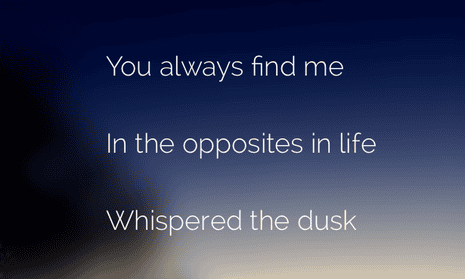HaikuJAM is a mobile app through which three people can connect to create poetic expressions together. With words and photos, folks can “jam” with friends or strangers, anywhere in the world. The framework is inspired by the ancient Japanese art of haiku, a very short form of poetry.
The collaborative process involves three “jammers” and each contributes a line or photograph, turn-by-turn-by-turn. Jammers can then share the created content through social media and also earn “karma” points for doing good in the app community. These deeds include loving jams or writing positive comments. Each day our team handpicks a number of inspiring collaborations, which are then featured on the app’s home screen.
The design of HaikuJAM is often described as “zen” and “elegant” – which makes sense as I practice meditation daily and I’m very much inspired by the concepts of stillness and channeling energy around the body. Such ideas have definitely played a role in the evolution of HaikuJAM’s aesthetic and user experience: the process of consuming content on the app is very “still” and deeply immersive, with beautiful full-screen photographs and crisp typography.
Before officially launching the app in March 2015, our hypothesis was that HaikuJAM would be a space for time-poor, creatively inclined people to engage in creative activities. Since launch, however, fascinating uses have emerged: a few people shared with us in confidence that they were suffering from clinical depression. For them, HaikuJAM was a place for self-expression and they saw the community as a support network, not just a group of content creators and consumers.
Some jammers have been using the app to improve their written English and vocabulary, and a significant number of our working professional users, from investment bankers to doctors, view the app as a tool for stress relief, escapism and reflection.
Each day, the average active user opens the app 15 times and spends between 30 and 35 minutes in the app overall. Close to 50% of our active users are also creating content. This year we graduated from the Oxygen Accelerator programme at Google Campus London and raised seed funding from the lead investors of JustGiving. My co-founder, Neer Sharma, and I are currently in San Francisco meeting product mentors, investors and other incredible people working in technology.
We’re off to a good start, but the road ahead is long and we have a lot to learn. For instance, a few weeks ago, in the process of ramping up our servers, we accidentally erased a portion of the database. We lost 14-days worth of content created in the app. This was a disaster. Determined to make the best out of an otherwise sad situation, with the support of the wonderful HaikuJAM community, we recovered some of the lost jams from the period and curated a free eBook, The Lost Weeks.
Other than the typical startup struggles around things such as fundraising, one of our biggest challenges is how we focus the value proposition considering such various uses. Can they simply coexist without detracting from the product’s core appeal? Reading Nick Bilton’s Hatching Twitter, it seemed that Twitter’s founders also struggled with this (albeit on a much grander scale) as the social network became a proverbial wild west with curiously nebulous sets of people and activities. The manner in which we leverage data, coupled with our own decision-making, will ultimately determine the future of HaikuJAM as a platform.
This year we’re going to further contextualise the creative experience through campaigns for brands, charities and around trending news events. We also want to curate the app’s fantastic creative content in the form of monthly book subscriptions and artistic merchandise. We also aim to introduce new mediums into the app, such as sound and video.
Our vision is deeply rooted in collaborative creativity, ie the “jam” in HaikuJAM. We care deeply about connecting humans to make beauty happen.
App facts
Length of the project: six months development on HaikuJAM Version 2.0
Companies involved: app studio Rosberry and other freelancers
Size of the team: five developers, one user interface designer and one product manager
Dhrupad Karwa is co-founder and CEO of HaikuJAM
Join our community of arts, culture and creative professionals by signing up free to the Guardian Culture Pros Network.

Comments (…)
Sign in or create your Guardian account to join the discussion